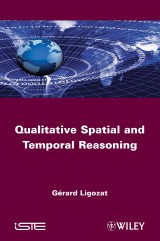Details

Qualitative Spatial and Temporal Reasoning
1. Aufl.
|
192,99 € |
|
| Verlag: | Wiley |
| Format: | EPUB |
| Veröffentl.: | 21.05.2013 |
| ISBN/EAN: | 9781118601563 |
| Sprache: | englisch |
| Anzahl Seiten: | 544 |
DRM-geschütztes eBook, Sie benötigen z.B. Adobe Digital Editions und eine Adobe ID zum Lesen.
Beschreibungen
Starting with an updated description of Allen's calculus, the book proceeds with a description of the main qualitative calculi which have been developed over the last two decades. It describes the connection of complexity issues to geometric properties. Models of the formalisms are described using the algebraic notion of weak representations of the associated algebras. The book also includes a presentation of fuzzy extensions of qualitative calculi, and a description of the study of complexity in terms of clones of operations.
<p>Introduction. Qualitative Reasoning xvii</p> <p><b>Chapter 1. Allen’s Calculus 1</b></p> <p>1.1. Introduction 1</p> <p>1.2. Allen’s interval relations 6</p> <p>1.3. Constraint networks 8</p> <p>1.4. Constraint propagation 17</p> <p>1.5. Consistency tests 26</p> <p><b>Chapter 2. Polynomial Subclasses of Allen’s Algebra 29</b></p> <p>2.1. “Show me a tractable relation!” 29</p> <p>2.2. Subclasses of Allen’s algebra 30</p> <p>2.3. Maximal tractable subclasses of Allen’s algebra 52</p> <p>2.4. Using polynomial subclasses 57</p> <p>2.5. Models of Allen’s language 60</p> <p>2.6. Historical note 61</p> <p><b>Chapter 3. Generalized Intervals 63</b></p> <p>3.1. “When they built the bridge . “ 63</p> <p>3.2. Entities and relations 65</p> <p>3.3. The lattice of basic (p, q)-relations 68</p> <p>3.4. Regions associated with basic (p, q)-relations 69</p> <p>3.5. Inversion and composition 73</p> <p>3.6. Subclasses of relations: convex and pre-convex relations 79</p> <p>3.7. Constraint networks 82</p> <p>3.8. Tractability of strongly pre-convex relations 83</p> <p>3.9. Conclusions 84</p> <p>3.10. Historical note 85</p> <p><b>Chapter 4. Binary Qualitative Formalisms 87</b></p> <p>4.1. “Night driving” 87</p> <p>4.2. Directed points in dimension 1 92</p> <p>4.3. Directed intervals 97</p> <p>4.4. The OPRA direction calculi 99</p> <p>4.5. Dipole calculi 100</p> <p>4.6. The Cardinal direction calculus 101</p> <p>4.7. The Rectangle calculus 104</p> <p>4.8. The n-point calculus 106</p> <p>4.9. The n-block calculus 108</p> <p>4.10. Cardinal directions between regions 109</p> <p>4.11. The INDU calculus 123</p> <p>4.12. The 2n-star calculi 126</p> <p>4.13. The Cyclic interval calculus 128</p> <p>4.14. The RCC–8 formalism 131</p> <p>4.15. A discrete RCC theory 137</p> <p><b>Chapter 5. Qualitative Formalisms of Arity Greater than 2 145</b></p> <p>5.1. “The sushi bar” 145</p> <p>5.2. Ternary spatial and temporal formalisms 146</p> <p>5.3. Alignment relations between regions 155</p> <p>5.4. Conclusions 158</p> <p><b>Chapter 6. Quantitative Formalisms, Hybrids, and Granularity 159</b></p> <p>6.1. “Did John meet Fred this morning?”159</p> <p>6.2. TCSP metric networks 160</p> <p>6.3. Hybrid networks 164</p> <p>6.4. Meiri’s formalism 168</p> <p>6.5. Disjunctive linear relations (DLR) 174</p> <p>6.6. Generalized temporal networks 175</p> <p>6.7. Networks with granularity 179</p> <p><b>Chapter 7. Fuzzy Reasoning 187</b></p> <p>7.1. “Picasso’s Blue period” 187</p> <p>7.2. Fuzzy relations between classical intervals 188</p> <p>7.3. Events and fuzzy intervals 195</p> <p>7.4. Fuzzy spatial reasoning: a fuzzy RCC 208</p> <p>7.5. Historical note 222</p> <p><b>Chapter 8. The Geometrical Approach and Conceptual Spaces 223</b></p> <p>8.1. “What color is the chameleon?” 223</p> <p>8.2. Qualitative semantics 224</p> <p>8.3. Why introduce topology and geometry? 225</p> <p>8.4. Conceptual spaces 226</p> <p>8.5. Polynomial relations of INDU 237</p> <p>8.6. Historical note 258</p> <p><b>Chapter 9. Weak Representations 259</b></p> <p>9.1. “Find the hidden similarity” 259</p> <p>9.2. Weak representations 261</p> <p>9.3. Classifying the weak representations of An 275</p> <p>9.4. Extension to the calculi based on linear orders 283</p> <p>9.5. Weak representations and configurations 290</p> <p>9.6. Historical note 304</p> <p><b>Chapter 10. Models of RCC−8 305</b></p> <p>10.1. “Disks in the plane” 305</p> <p>10.2. Models of a composition table 307</p> <p>10.3. The RCC theory and its models 312</p> <p>10.4. Extensional entries of the composition table 319</p> <p>10.5. The generalized RCC theory 329</p> <p>10.6. A countable connection algebra 337</p> <p>10.7. Conclusions 341</p> <p><b>Chapter 11. A Categorical Approach of Qualitative Reasoning 343</b></p> <p>11.1. “Waiting in line” 343</p> <p>11.2. A general construction of qualitative formalisms 346</p> <p>11.3. Examples of partition schemes 349</p> <p>11.4. Algebras associated with qualitative formalisms 350</p> <p>11.5. Partition schemes and weak representations 352</p> <p>11.6. A general definition of qualitative formalisms 353</p> <p>11.7. Interpretating consistency 355</p> <p>11.8. The category of weak representations 357</p> <p>11.9. Conclusions 360</p> <p><b>Chapter 12. Complexity of Constraint Languages 363</b></p> <p>12.1. “Sudoku puzzles” 363</p> <p>12.2. Structure of the chapter 365</p> <p>12.3. Constraint languages 366</p> <p>12.4. An algebraic approach of complexity 367</p> <p>12.5. CSPs and morphisms of relational structures 368</p> <p>12.6. Clones of operations 373</p> <p>12.7. From local consistency to global consistency 375</p> <p>12.8. The infinite case 376</p> <p>12.9. Disjunctive constraints and refinements 382</p> <p>12.10. Refinements and independence 389</p> <p>12.11. Historical note 390</p> <p><b>Chapter 13. Spatial Reasoning and Modal Logic 391</b></p> <p>13.1. “The blind men and the elephant” 391</p> <p>13.2. Space and modal logics 393</p> <p>13.3. The modal logic S4 393</p> <p>13.4. Topological models 396</p> <p>13.5. Translating the RCC−8 predicates 408</p> <p>13.6. An alternative modal translation of RCC−8 409</p> <p>13.7. Generalized frames 410</p> <p>13.8. Complexity 411</p> <p>13.9. Complements 412</p> <p><b>Chapter 14. Applications and Software Tools 413</b></p> <p>14.1. Applications 413</p> <p>14.2. Software tools 416</p> <p><b>Chapter 15. Conclusion and Prospects 423</b></p> <p>15.1. Introduction 423</p> <p>15.2. Combining qualitative formalisms 423</p> <p>15.3. Spatio-temporal reasoning 426</p> <p>15.4. Alternatives to qualitative reasoning 430</p> <p>15.5. To conclude — for good 434</p> <p><b>Appendix A. Elements of Topology 435</b></p> <p>A.1. Topological spaces 435</p> <p>A.2. Metric spaces 445</p> <p>A.3. Connectedness and convexity 447</p> <p><b>Appendix B. Elements of Universal Algebra 451</b></p> <p>B.1. Abstract algebras 451</p> <p>B.2. Boolean algebras 452</p> <p>B.3. Binary relations and relation algebras 454</p> <p>B.4. Basic elements of the language of categories 457</p> <p><b>Appendix C. Disjunctive Linear Relations 463</b></p> <p>C.1. DLRs: definitions and satisfiability 463</p> <p>C.2. Linear programming 464</p> <p>C.3. Complexity of the satisfiability problem 466</p> <p>Bibliography 471</p> <p>Index 501</p>
<p><strong>Gérard Ligozat</strong> is retired professor of computer science, Paris-Sud University.

















